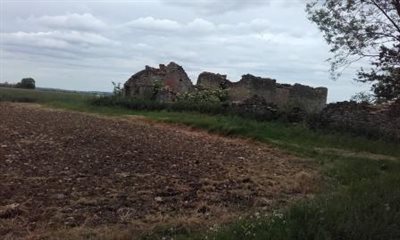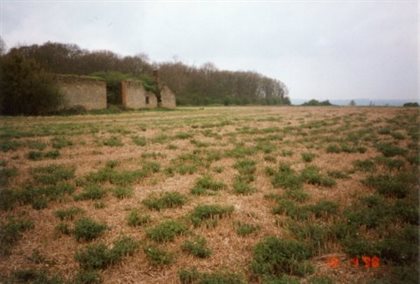Freer's Wood Farm
This page was written by Pamela Hider

Ruins of a farm cottage May 2019
The evocative ruins of this farm cottage are all that remain today. They stand next to the ancient woodland of Freer's Wood and east of the area known as Ruff's Green, site of one of the three clusters of houses which formed the medieval village of Chellington.
Freer's Wood Farm is not on any maps prior to the 19th century, so we can presume it would've been built shortly after the beginning of that century, possibly after the Enclosure Act of 1806. Thereafter, the farm cottage appears in each census from 1841 - 1901, but was not mentioned in the census of 1911 - the reason for this may be that at the end of October 1910, it was part of one of four lots listed for auction in a sale catalogue of Collins & Collins (PK2/2/33). It was described as follows: "Comprising Stock Yard with Barn, open Cattle Sheds, Cow Houses and Labourer's Cottage." In the same Lot as nearby Hill Farm & Lodge Farm, we learn that the whole of this lot had been let to Messrs.H.E. & E.E. Medlow who had been tenants for almost thirty years. Freer's Wood next appears in the Electoral Rolls of 1924 -1926 in the tenancy of Sidney G.Franklin, but by 1927, when farms were valued under the Rating & Valuation Act of 1925, the description read ‘not a good cottage, no water, v.poor’ (DV1/A2). The farm buildings, however, were described as ‘excellent, water obtained from hills and laid on to Hill Farm & Lodge Farm’ (DV1/H18).”
The farm cottage was last occupied during the Second World War by a shoe-mender, his wife and children. Apparently the British Legion bought him a leather stitching machine to ‘help get him on his feet’. (Unpublished memoir of Carlton & Chellington Historical Society).
In May 1944 it was listed for auction in a sale catalogue of Jackson Stops & Staff as a "vacant cottage with 4 rooms...stone & tiled" (Z/528/1). It then appears in electoral rolls again from 1945 - 1951, having had five lots of tenants during those few years. It must have been after this time that it went into disuse, as after 1951 there are no more records. However, its days were almost ended in July 1944, when it did have a lucky escape as the following article describes:
Extract from ‘The Route As Briefed’ (History of The 92nd Bomb Group 1942-45): "An afternoon practice mission on July 15 turned out fatally for three members of the crew of 1st Lt John A. Alford of the 326th Squadron. Upon attempting to land after the mission the wheels bounced on the runway and the aircraft was airborne again, with one wing bursting into flames. Lt Alford climbed to about 900 feet, levelled off and ordered the crew to bale out; the plane crashed and burned about six miles south of the base. 2nd Lt Stanley Nadel, the navigator, and T/Sgt Paul R. Horton were killed. Sgt Bruce C. Baker, Jr., the ball turret gunner, parachuted out but his chute streamed down and failed to canopy, and he was killed immediately upon impact with the ground. Lt Alford and his co-pilot, 2nd Lt Robert E. Williams parachuted safely without injury; T/Sgt Thomas J. Madden, the engineer, parachuted safely with only slight skin lacerations."
This was B17 42-31898 and it crashed at Freer’s Wood at about 4.40pm on a Saturday 15th July 1944.
Jim Northern of Harrold recalls that he was picking raspberries behind his parents farm when he saw the aircraft going down trailing black smoke with just two engines operating. Mrs Gardner of Grove Road, Turvey, at that time living at Carlton, also saw its final moments from her house which was at the Pavenham end of the village, a few fields away from Freer's Wood. Being used to the sound and sight of aircraft she could tell that it was in trouble. Through her front window what appeared to be parcels could be seen dropping out, but it was quickly realised that this was the crew abandoning the stricken bomber and, with it heading their way, she rushed outside to call in her young son. Fortunately it did not reach them and a few minutes later jeeps and ambulances from Podington rushed past the house and up the road towards the crash site.

Freer's Wood beyond the ruins of the farm (mid 1990s).The aircraft came in from the right in this picture.
Today, as you walk the footpath that runs along the north side Freer’s Wood past the deserted buildings of Freer’s Wood Farm towards Chellington, there is little to mark the spot where the 19 ton bomber struck the field before exploding into the wood, and only a few small pieces of perspex and twisted aluminium turned up by the plough provide a clue to the drama and devastation of that day.
(Article reproduced courtesy of Colin Mackenzie - author of Local Aviation History)